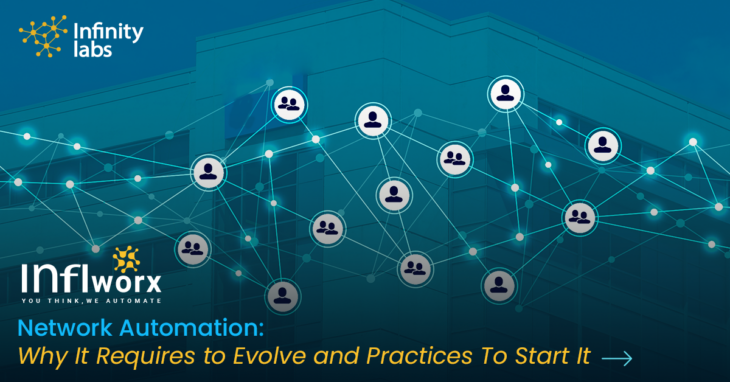
This is a digital space where businesses are connected through the internet. Thus, networks play a crucial role in keeping things running smoothly. Whether it’s sending an email, streaming a video, or conducting a business transaction online, networks are important. Also, networks are considered the backbone of digital life. To ensure these networks operate efficiently, network automation has become increasingly important. However, as technology advances, there will be a need to evolve network automation. This is because it will be helpful to meet the growing demands of modern connectivity.
Here’s the blog that will let you know about automation, why it needs to evolve, and some crucial practices that are needed to start it.
The need for evolution for network automation
Before we learn anything else, we must know the need for the evolution of network automation:
1. Increasing complexity
Networks have become more complex with the use of numerous devices, applications, and services. Traditional methods of network management are no longer sufficient to handle this complexity. This is why, there’s a need for evolving network automation that can help streamline processes. In addition to this, it will make networks more reliable and secure.
2. Rise of cloud computing and virtualization
Today, organizations are moving their workloads to the cloud and adopting virtualized infrastructure. Organizations relying on traditional network management approaches may also need to migrate to cloud computing.
Modern networks can support cloud-native applications and accommodate fluctuating workloads. By evolving network automation, businesses will get seamless integration with cloud platforms and virtualization technologies.
3. Security concerns
Cyber threats are becoming more common because of more number of access points. This poses significant risks to the network infrastructure and data integrity of the organizations. In this situation, evolving network automation can incorporate security measures into automated processes. It helps detect and respond to security issues and reduces the risk of breaches and data loss.
Addressing organizational challenges with network automation
Automation uses its network automation tools to address various organizational challenges and network complexities. These are:
1. Integration and Security
For many organizations, the integration with existing systems and legacy infrastructure can be complex. This requires careful planning and coordination. Security and compliance considerations must also be addressed to ensure that automated processes.
2. Organizational security shift
Evolving network automation requires a shift in organizational culture. Network engineers will have to make manual changes. However, organizations can empower their teams to embrace automation which can help in fixing the security issues.
Practices required to get started with network automation
Starting with network automation might feel like a big task, but it benefits quickly. Are you thinking of deploying automation for your enterprise network? Well, for this, you need to get started with some important practices. Here are some simple tips to begin:
1. Start automating small tasks
Organizations should begin with simple tasks instead of trying to automate everything at once. You could set up automation to search for solutions in case of network issues. This way, your IT team can quickly find solutions and reduce the time it takes to fix problems. This will help improve the overall performance of your network.
2. Compare before and after
Before making any changes to your network automation processes, you must first measure the current performance. This includes tracking response times, downtime, and user satisfaction.
After implementing automation changes, you must continue to monitor these metrics. This will help you understand that IT automation is making changes to achieve desired results. IT team can use different tools that will help you gather and analyze this data effectively.
3. Consider about security
When implementing automation to your network, it’s crucial to consider security at every step. So, the organization must ensure to review each automated action. This will help you to know that it is completely safe and won’t compromise your network.
Thus, you must also first set up permissions carefully to ensure that only authorized users can access sensitive data of your network. In addition to this, use read-only tasks whenever possible to minimize the risk of unauthorized access.
4. Requires some level of control
If you’re migrating to automation or deploying it for the first time then it’s important to retain some level of control. This is crucial, especially in the early stages of automation implementation.
Thus, the organization needs to implement an approval process for automated tasks. This must also ensure that changes are reviewed and approved by It staff before being executed.
5. Use of automation tools
Having multiple automation tools can add unnecessary complexity to your network. So, you can use automation tools as much as possible. Consolidating your tools makes it easier to manage and maintain your automation processes over time.
6. Give training to your IT team and network engineers
As network complexity continues to grow, it’s essential to ensure that your team has the right skills. The skills and knowledge of network automation platforms will help them to manage and maintain automated systems effectively. This is the reason why you must give training to the IT team so that they can cover both traditional networking skills and new technologies related to automation.
By equipping your team with the necessary knowledge and skills, they can manage the network issues and rectify them.
To sum up
So, network automation is bringing changes to organizations. However, it may require to evolve after some time to equip advanced features. In addition to this, these given practices will be helpful for an organization if they are implementing network automation for the first time. An enterprise can improve its success and enhance the efficiency, reliability, and security of its network infrastructure by following these tips.